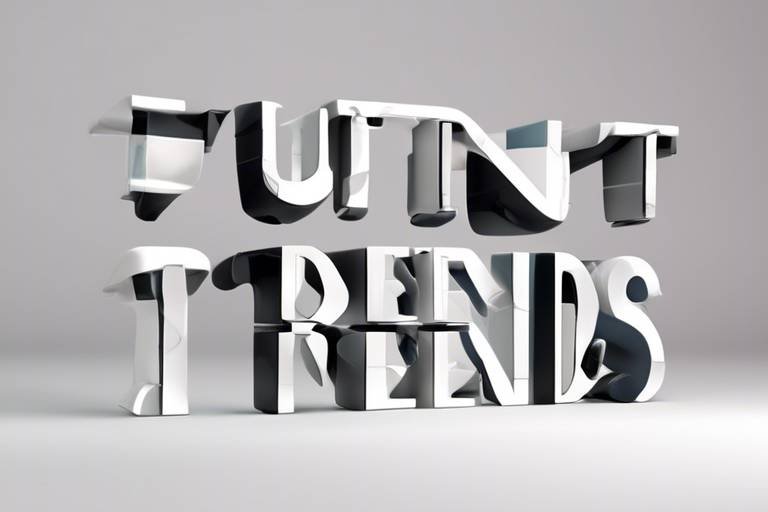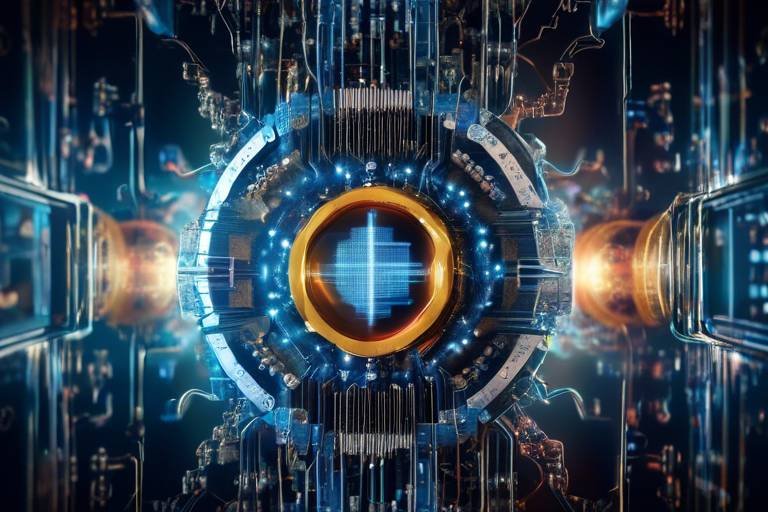The Impact of 3D Printing on Manufacturing Industries
3D printing, often referred to as additive manufacturing, is not just a technological fad; it's a game changer that is reshaping the manufacturing landscape. Imagine a world where products are made on-demand, reducing the need for vast warehouses filled with inventory. This is the reality that 3D printing brings to the table. By creating objects layer by layer, manufacturers can produce complex designs that were once deemed impossible or too costly. This revolutionary approach not only enhances efficiency but also significantly reduces production costs. As we delve deeper into the applications and implications of 3D printing across various industries, you'll see how this technology is paving the way for a more innovative and sustainable future.
At its core, 3D printing is about building objects from the ground up. Using a digital model, printers deposit materials—whether plastic, metal, or even biological substances—layer by layer until the final product emerges. This process differs dramatically from traditional subtractive manufacturing methods, where material is cut away to create an object. The beauty of 3D printing lies in its ability to create intricate designs and customized products without the need for extensive tooling or setup. As industries begin to embrace this technology, understanding its principles becomes essential for grasping its profound impact on manufacturing.
The aerospace industry is one of the frontrunners in adopting 3D printing technology. By producing lightweight components, manufacturers can enhance fuel efficiency and reduce overall production time. For instance, companies like Boeing and Airbus are utilizing 3D printing to create parts such as brackets and ducts that are not only lighter but also more durable than their traditionally manufactured counterparts. This shift not only leads to significant cost savings but also allows for more innovative designs that can improve aircraft performance. The benefits are clear:
- Weight Reduction: Lighter parts contribute to lower fuel consumption.
- Shorter Lead Times: Rapid prototyping allows for quicker design iterations.
- Complex Geometries: The ability to create intricate designs that were previously impossible.
In the automotive sector, 3D printing is revolutionizing the way vehicles are designed and manufactured. Rapid prototyping enables engineers to test ideas quickly, leading to faster innovation cycles. Custom parts production is another significant advantage, allowing manufacturers to create specialized components tailored to individual customer needs. This flexibility not only enhances the customer experience but also reduces waste, as parts can be produced as needed rather than in large batches. The automotive industry is witnessing:
- Cost Efficiency: Reduced material waste and lower production costs.
- Customization: Unique designs that cater to specific consumer demands.
- Faster Time to Market: Speeding up the development process for new models.
In the medical field, 3D printing is nothing short of revolutionary. It allows for the creation of prosthetics and implants that are custom-fitted to individual patients. Imagine a prosthetic limb designed specifically for a person’s unique anatomy, improving comfort and functionality. Hospitals and clinics are leveraging this technology to produce surgical models, enabling surgeons to plan complex operations with greater precision. The benefits of 3D printing in medicine include:
- Personalization: Tailored solutions for each patient.
- Reduced Costs: Lower manufacturing costs lead to more affordable healthcare solutions.
- Shorter Lead Times: Quicker production of vital medical devices.
Despite its numerous advantages, 3D printing is not without its challenges. Material limitations are a significant concern; not all materials are suitable for every application, and finding the right material can be a daunting task. Additionally, while 3D printing can produce items quickly, the speed of production can still lag behind traditional methods for larger batches. Manufacturers must navigate these obstacles to fully leverage the technology's potential. Addressing these challenges will be crucial for the future of 3D printing in manufacturing.
One of the most promising aspects of 3D printing is its potential to reduce waste and energy consumption in manufacturing processes. Traditional manufacturing often results in significant material waste, whereas 3D printing uses only the material necessary to create an object. This not only conserves resources but also minimizes the environmental footprint of production. As industries strive for greater sustainability, 3D printing presents a viable solution to reduce energy use and promote eco-friendly manufacturing practices.
As technology continues to evolve, new trends in 3D printing are emerging. Innovations in materials, such as bio-based plastics and metals, are expanding the possibilities of what can be produced. Furthermore, advancements in printer technology are making it possible to create larger and more complex items. The future of 3D printing holds exciting potential, with anticipated developments that could revolutionize manufacturing across various sectors.
Numerous real-world examples illustrate the successful implementation of 3D printing in various sectors. For instance, General Electric has utilized 3D printing to manufacture fuel nozzles for jet engines, resulting in a part that is 25% lighter and five times more durable than traditional components. Similarly, Adidas has embraced 3D printing to create customized footwear, allowing for a perfect fit tailored to individual athletes. These case studies showcase the transformative impact of 3D printing and its ability to drive innovation.
In conclusion, 3D printing is undeniably reshaping the manufacturing landscape. From aerospace to healthcare, its applications are vast and varied, offering numerous benefits such as cost savings, enhanced efficiency, and innovative designs. As we look to the future, the continued evolution of this technology promises even greater advancements and possibilities. The journey of 3D printing has only just begun, and its potential for further innovation is limitless.
Q: What industries are most impacted by 3D printing?
A: Industries such as aerospace, automotive, and healthcare are significantly impacted due to their need for customization, rapid prototyping, and innovative designs.
Q: What are the limitations of 3D printing?
A: Limitations include material constraints, slower production speeds for larger quantities, and the need for specialized knowledge to operate advanced printers.
Q: How does 3D printing benefit the environment?
A: 3D printing reduces waste by using only the necessary materials for production and can lower energy consumption compared to traditional manufacturing methods.

Introduction to 3D Printing
Welcome to the fascinating world of 3D printing, also known as additive manufacturing. This revolutionary technology is not just a passing trend; it’s a game changer that’s reshaping how we think about production and design. Imagine being able to create a complex object simply by pressing a button—sounds like science fiction, right? But that’s the magic of 3D printing! It works by building objects layer by layer, which allows for incredible precision and creativity.
At its core, 3D printing utilizes digital models to guide the manufacturing process. This means that a computer file can be transformed into a physical item, whether it’s a prototype, a custom part, or even a finished product. The technology employs various materials, including plastics, metals, and even biological substances, to create these objects. The beauty of 3D printing lies in its versatility and the endless possibilities it offers across different sectors.
But what exactly does this mean for manufacturers? Well, for starters, 3D printing significantly enhances efficiency. Traditional manufacturing methods often involve lengthy processes, including molding and machining, which can take weeks or even months. In contrast, 3D printing can produce complex parts in a fraction of the time, allowing companies to respond to market demands more swiftly. This speed not only boosts productivity but also reduces costs associated with labor and materials.
Moreover, 3D printing opens the door to innovative designs that were previously impossible or prohibitively expensive. With the ability to create intricate geometries and customized solutions, manufacturers can now cater to specific customer needs without the constraints of traditional manufacturing techniques. This flexibility encourages creativity and pushes the boundaries of what’s possible in product design.
In summary, 3D printing is more than just a technological advancement; it’s a revolution in manufacturing. By understanding its principles and applications, we can better appreciate its transformative impact across various industries. As we delve deeper into specific sectors like aerospace, automotive, and medical, you’ll see just how profound this technology's influence is. Buckle up; the journey into the world of 3D printing is just beginning!

Applications in Aerospace
The aerospace industry is often seen as the pinnacle of engineering and innovation, and with the emergence of 3D printing technology, it has taken a giant leap forward. Imagine being able to create complex components that are not only lightweight but also tailored to specific performance requirements. That's precisely what 3D printing offers. By utilizing additive manufacturing, aerospace engineers can produce parts layer by layer, allowing for intricate designs that traditional manufacturing methods simply can't achieve.
One of the most significant advantages of 3D printing in aerospace is the ability to create lightweight components. In an industry where every gram counts, reducing weight translates directly into improved fuel efficiency and reduced operational costs. For instance, companies like Boeing and Airbus are already using 3D printing to manufacture parts such as brackets, ducts, and even engine components. These parts not only weigh less but also exhibit enhanced strength characteristics, allowing for safer and more efficient aircraft.
Another fascinating application is in the realm of rapid prototyping. Traditional prototyping can take weeks or even months, but with 3D printing, engineers can develop prototypes in a matter of days. This speed allows for quicker iterations and testing, ultimately accelerating the development cycle. Imagine being able to test a new design within days instead of waiting for traditional manufacturing processes to catch up. This agility not only saves time but also significantly reduces costs.
Furthermore, 3D printing enables the production of customized parts that meet specific requirements. For example, if an aircraft needs a unique component that is not available off-the-shelf, 3D printing can produce that part quickly and efficiently. This capability is especially beneficial for maintaining older aircraft models, where finding replacement parts can be a challenge. The ability to print these parts on-demand means that airlines can keep their fleets operational without the lengthy delays associated with traditional supply chains.
However, the applications of 3D printing in aerospace go beyond just manufacturing and prototyping. The technology is also paving the way for design innovations. Engineers can now explore geometries that were previously impossible to manufacture, leading to new designs that enhance performance and efficiency. For instance, lattice structures can be created to optimize strength while minimizing weight, a feat that would be incredibly difficult to achieve with conventional methods.
In summary, the applications of 3D printing in the aerospace industry are not just revolutionary; they are essential for the future of aviation. As the technology continues to evolve, we can expect to see even more innovative uses that will further enhance efficiency, reduce costs, and push the boundaries of what is possible in aerospace engineering. With such transformative potential, it's exciting to think about where this technology will take us next.

Benefits in Automotive Manufacturing
In the fast-paced world of automotive manufacturing, 3D printing is nothing short of a game-changer. It brings a whirlwind of benefits that are reshaping how cars are designed, produced, and brought to market. Imagine being able to create complex parts that were once deemed impossible with traditional manufacturing techniques. That's the magic of 3D printing! This technology allows manufacturers to produce lightweight components, which not only enhances vehicle performance but also boosts fuel efficiency. It's like trading in your old clunker for a sleek, high-tech sports car—everything just works better!
One of the standout advantages of 3D printing in the automotive industry is its ability to enable rapid prototyping. Instead of spending weeks or even months developing a new part, engineers can now create a prototype in a matter of days. This speed allows for quicker iterations and refinements, which means that the final product is more likely to meet consumer needs and preferences. It’s akin to having a magic wand that lets you test drive your ideas before committing to them fully.
Moreover, the customization capabilities of 3D printing are revolutionizing how automotive manufacturers approach production. Whether it's creating custom-fit parts for individual vehicles or designing unique components for limited-edition models, the possibilities are endless. For instance, a car enthusiast can dream up a bespoke design, and with 3D printing, that dream can become a reality without the usual constraints of mass production.
Cost savings are another significant benefit of adopting 3D printing technology. Traditional manufacturing often involves high setup costs and large inventories. However, with 3D printing, manufacturers can produce parts on-demand, reducing the need for extensive inventory and minimizing waste. This not only cuts costs but also leads to a more sustainable manufacturing process. Think of it as clearing out your garage—less clutter and more space for what truly matters!
To illustrate the impact of 3D printing in automotive manufacturing, let's take a look at some key statistics:
| Statistic | Impact |
|---|---|
| Reduction in prototyping time | Up to 75% |
| Cost savings on production | Up to 50% |
| Reduction in material waste | Up to 90% |
As we delve deeper into the automotive landscape, it's clear that 3D printing is not just a passing trend; it’s a revolution. The ability to create complex, lightweight, and customized parts is enhancing not just the manufacturing process but also the overall driving experience. With each innovation, we inch closer to a future where vehicles are more efficient, more personalized, and more exciting than ever before. Who wouldn't want to be a part of that?
So, as we buckle up for the ride ahead, it’s evident that 3D printing is steering the automotive industry toward uncharted territories of innovation and efficiency. The road ahead looks bright, and the benefits of this technology are just beginning to unfold.
- What is 3D printing? 3D printing, or additive manufacturing, is a process that creates three-dimensional objects by layering materials based on digital models.
- How does 3D printing benefit automotive manufacturing? It allows for rapid prototyping, customization, cost savings, and the production of lightweight components, enhancing overall efficiency.
- Are there any downsides to 3D printing in automotive manufacturing? Yes, challenges include material limitations and slower production speeds compared to traditional methods.
- What future trends can we expect in 3D printing for the automotive industry? Anticipated trends include advancements in materials, increased automation, and broader adoption of 3D printing technologies across different manufacturing stages.

Medical Advancements through 3D Printing
3D printing is not just a buzzword in the manufacturing world; it’s a groundbreaking innovation that is making waves in the medical field. Imagine a world where prosthetics are not only functional but also perfectly tailored to the unique anatomy of each patient. This is no longer a distant dream but a reality, thanks to the capabilities of additive manufacturing. With 3D printing, medical professionals can create custom implants, prosthetics, and even complex tissue structures that are revolutionizing patient care.
One of the most significant advancements is in the production of prosthetics. Traditional methods of creating prosthetic limbs can be time-consuming and expensive. However, with 3D printing, the process becomes more efficient. By using digital scans of a patient's limb, manufacturers can design and print a prosthetic that fits perfectly, reducing the time from weeks to just a few days. This not only enhances patient comfort but also boosts their confidence, allowing them to regain mobility and independence faster than ever before.
Moreover, 3D printing is paving the way for customized implants that cater to individual patient needs. For example, orthopedic implants can be designed to match the exact contours of a patient’s bone structure, leading to better integration and reduced recovery times. The ability to print with biocompatible materials further ensures that these implants are safe and effective. The table below summarizes some key benefits of 3D printing in medical applications:
| Application | Benefits |
|---|---|
| Prosthetics | Custom fit, reduced production time, lower costs |
| Implants | Personalized design, improved integration, faster recovery |
| Surgical Models | Enhanced pre-surgical planning, improved outcomes |
In addition to prosthetics and implants, 3D printing is also making strides in the creation of surgical models. Surgeons can now print a replica of a patient’s anatomy, allowing them to practice complex procedures beforehand. This not only boosts the surgeon's confidence but also minimizes the risks during actual surgeries, leading to better patient outcomes. Imagine the peace of mind for patients knowing that their surgeon has rehearsed their operation on a 3D-printed model of their own body!
However, it’s not all smooth sailing. As with any technology, there are challenges that need to be addressed. The regulatory landscape for 3D-printed medical devices is still evolving, and manufacturers must navigate a complex web of guidelines to ensure safety and efficacy. Additionally, the materials used in 3D printing must meet stringent medical standards, which can limit the options available for production.
Despite these challenges, the future of 3D printing in medicine looks incredibly promising. As technology continues to advance, we can expect even more innovative applications that will transform the landscape of healthcare. From bioprinting organs to creating complex tissue structures, the possibilities are endless. This is just the beginning, and as we embrace these advancements, we are not only improving medical procedures but also enhancing the quality of life for countless individuals.
- What is 3D printing in medicine? 3D printing in medicine refers to the use of additive manufacturing to create medical devices, prosthetics, implants, and even biological tissues tailored to individual patient needs.
- How does 3D printing benefit prosthetics? It allows for custom-fit designs that can be produced quickly and at a lower cost, greatly enhancing patient comfort and satisfaction.
- Are 3D-printed medical devices safe? Yes, but they must meet strict regulatory standards to ensure safety and efficacy before being used in medical applications.

Challenges and Limitations
While 3D printing is undoubtedly a game-changer in the manufacturing sector, it doesn't come without its . One of the primary hurdles is the material constraints. Currently, the range of materials that can be effectively used in 3D printing is limited compared to traditional manufacturing methods. Most 3D printers primarily work with plastics, metals, and some composites, which can restrict the types of products that can be created. This limitation poses a significant challenge, especially in industries that require specific material properties, such as high strength or heat resistance.
Another pressing issue is production speed. Although 3D printing is excellent for creating prototypes and small batches of products, it often lacks the speed required for mass production. For instance, while traditional manufacturing techniques can churn out thousands of units in a short time, 3D printing can take hours or even days to produce a single item, depending on its complexity. This slower pace can be a deal-breaker for companies that rely on quick turnaround times to meet market demands.
Moreover, the cost of equipment and materials can be a barrier to entry for many businesses. High-quality 3D printers and the specialized materials they require can be quite expensive. This initial investment can deter smaller companies from adopting this technology, limiting its widespread use. Additionally, the ongoing maintenance and the need for skilled personnel to operate these machines can further add to the costs.
Furthermore, there are regulatory and safety concerns associated with 3D printing, particularly in industries like aerospace and healthcare. The lack of standardized regulations can lead to uncertainties regarding the quality and safety of 3D printed products. For example, in the aerospace sector, components must meet rigorous safety standards. If a 3D printed part fails during flight, the consequences can be catastrophic. Therefore, establishing clear guidelines and quality assurance processes is essential to mitigate these risks.
Lastly, intellectual property issues are becoming increasingly relevant as 3D printing technology evolves. With the ability to easily replicate designs, businesses face the challenge of protecting their innovations from being copied without permission. This situation raises questions about ownership and copyright in the digital age, creating a complex legal landscape that manufacturers must navigate.
In summary, while 3D printing offers incredible potential for innovation and efficiency, it also presents significant challenges that manufacturers must address to fully harness its capabilities. Overcoming these obstacles will require collaboration between industry leaders, researchers, and policymakers to create solutions that enable the technology to thrive.
- What are the main materials used in 3D printing? The most common materials include plastics, metals, and some composites, but the range is expanding as technology advances.
- How does 3D printing compare to traditional manufacturing? 3D printing is excellent for prototyping and custom parts but generally slower and more expensive for mass production.
- What are the safety concerns with 3D printed products? Regulatory standards are still being established, particularly in high-stakes industries like aerospace and healthcare.
- How can businesses protect their designs in 3D printing? Companies should consider legal measures such as patents and trademarks to safeguard their intellectual property.

Environmental Impact
In today's world, where environmental concerns are at the forefront of global discussions, the role of 3D printing in manufacturing offers a glimmer of hope. This innovative technology, often referred to as additive manufacturing, has the potential to significantly reduce waste and energy consumption compared to traditional manufacturing methods. Imagine a world where products are created with minimal excess material and energy, leading to a more sustainable future. Sounds appealing, right?
One of the most notable environmental advantages of 3D printing is its ability to create objects layer by layer, which means that only the necessary amount of material is used in the production process. Unlike subtractive manufacturing, where material is cut away to form a product, 3D printing ensures that less material goes to waste. This efficiency not only conserves resources but also lowers production costs, making it a win-win for manufacturers and the environment alike.
Moreover, 3D printing can significantly reduce the carbon footprint associated with transportation. By enabling localized production, companies can manufacture products closer to their end-users, minimizing the need for long-distance shipping. This shift not only decreases fuel consumption but also reduces greenhouse gas emissions, contributing to a healthier planet.
To illustrate the environmental benefits, let's consider some statistics:
| Factor | Traditional Manufacturing | 3D Printing |
|---|---|---|
| Material Waste | Up to 90% | Less than 10% |
| Energy Consumption | High | Lower |
| Transportation Emissions | High | Reduced |
While the benefits are clear, it's essential to acknowledge that 3D printing is not without its challenges. The materials used in 3D printing, such as certain plastics, can still pose environmental concerns if not managed properly. However, the industry is actively exploring sustainable materials, including biodegradable options and recycled materials, to further enhance the eco-friendliness of this technology.
In conclusion, the environmental impact of 3D printing is undeniably positive, offering a pathway towards more sustainable manufacturing practices. As the technology continues to evolve, it holds the promise of not only transforming industries but also playing a critical role in preserving our planet for future generations. By embracing this innovative approach, manufacturers can contribute to a greener future while reaping the benefits of efficiency and cost savings.
- What are the main environmental benefits of 3D printing? 3D printing reduces material waste, lowers energy consumption, and minimizes transportation emissions.
- Can 3D printing use sustainable materials? Yes, the industry is exploring biodegradable and recycled materials to enhance sustainability.
- How does 3D printing compare to traditional manufacturing in terms of environmental impact? 3D printing generally has a lower environmental impact, producing less waste and requiring less energy.

Future Trends in 3D Printing
As we look ahead, the landscape of 3D printing is set to evolve at an unprecedented pace. This technology, which has already made waves across various industries, is poised to introduce even more groundbreaking innovations. One of the most exciting trends is the integration of artificial intelligence (AI) with 3D printing. Imagine machines that can not only print but also learn from their processes, optimizing designs and materials in real-time. This synergy could lead to unprecedented efficiency, reducing both time and costs significantly.
Another trend to watch for is the rise of bioprinting. This involves using 3D printing technology to create biological structures, such as tissues and organs. While we are still in the early stages, the potential for medical advancements is staggering. Picture a future where patients can receive custom-designed organs that perfectly match their biological makeup, drastically reducing the risk of rejection. This could revolutionize organ transplants and save countless lives.
Additionally, the use of sustainable materials in 3D printing is gaining traction. As environmental concerns continue to grow, manufacturers are increasingly seeking ways to minimize waste and reduce their carbon footprint. By utilizing recycled plastics and biodegradable materials, the industry can not only enhance its sustainability efforts but also appeal to a more eco-conscious consumer base. This shift towards green manufacturing practices is not just a trend; it’s becoming a necessity.
Moreover, decentralized manufacturing is on the rise. With the ability to print products on-demand, companies are moving away from large-scale factories towards localized production. This means that instead of shipping products worldwide, manufacturers can produce items closer to the consumer, reducing shipping costs and delivery times. It’s like having a mini-factory right in your neighborhood!
Finally, we can't overlook the role of cloud-based 3D printing services. Just as traditional printing has evolved with cloud technology, so too will 3D printing. Businesses will be able to upload designs to a cloud service, where they can be printed on demand. This opens up a world of possibilities for small businesses and startups, allowing them to access high-quality printing without the need for expensive equipment.
In summary, the future of 3D printing is bright, filled with potential advancements that could reshape industries. From AI-driven optimization to sustainable practices and localized manufacturing, the possibilities are endless. The question is, are you ready to embrace this technological revolution?
- What industries will benefit the most from 3D printing?
Industries such as aerospace, automotive, healthcare, and consumer goods are expected to see significant benefits from 3D printing technology due to its ability to create custom parts and reduce production times.
- Is 3D printing environmentally friendly?
Yes, when using sustainable materials and reducing waste in production, 3D printing can be more environmentally friendly compared to traditional manufacturing methods.
- How does bioprinting work?
Bioprinting uses 3D printing technology to layer living cells to create tissues and organs, potentially leading to breakthroughs in medical treatments.
- What are the limitations of 3D printing?
Some limitations include material constraints, production speed, and the need for skilled professionals to operate and maintain the technology.

Case Studies of Success
When it comes to 3D printing, the proof is in the pudding! Numerous companies across various industries have embraced this technology, leading to remarkable advancements and efficiencies. Let's dive into some compelling case studies that showcase the transformative power of 3D printing.
One standout example is Boeing, a giant in the aerospace sector. Boeing has integrated 3D printing into its manufacturing processes to produce lightweight parts that significantly enhance fuel efficiency. For instance, the company has successfully printed a series of fuel nozzles for its 737 MAX aircraft. By using additive manufacturing, Boeing reduced the weight of these components by about 25%, which translates to lower operational costs and a smaller carbon footprint. This innovation not only speeds up production but also allows for complex designs that traditional manufacturing methods simply can't achieve.
Moving on to the automotive industry, Ford is making waves with its use of 3D printing for rapid prototyping. In one notable case, Ford utilized 3D printing to create a prototype of a new car part, which allowed engineers to test and iterate designs quickly. This rapid prototyping process slashed development time by nearly 60%, enabling Ford to bring new models to market faster than ever before. The ability to customize parts on demand also means that Ford can cater to specific customer preferences without the burden of extensive inventory.
In the realm of medicine, Materialise has pioneered the use of 3D printing for creating patient-specific prosthetics and implants. A remarkable case involved a young boy who needed a custom-made prosthetic arm. By using 3D scanning and printing technology, Materialise was able to produce a lightweight, perfectly fitted prosthetic that allowed the boy to regain his mobility and confidence. This case highlights not only the technical capabilities of 3D printing but also its profound impact on individual lives.
Furthermore, the University of California, Berkeley, has been at the forefront of 3D printing research, particularly in the field of bioprinting. Researchers successfully printed living tissues that can be used for drug testing and potentially for organ transplants in the future. This groundbreaking work opens the door for significant advancements in medical science, offering hope for patients awaiting organ transplants.
To summarize, these case studies exemplify the myriad ways in which 3D printing is reshaping industries. From aerospace to automotive and healthcare, the technology is not just a trend; it's a catalyst for innovation. As we look ahead, the continuous evolution of 3D printing promises to unlock even more possibilities, pushing the boundaries of what we can achieve in manufacturing.
- What industries benefit the most from 3D printing?
Industries such as aerospace, automotive, and healthcare are leading the charge in adopting 3D printing technology due to its ability to enhance efficiency and reduce costs.
- Is 3D printing environmentally friendly?
Yes, 3D printing can reduce waste and energy consumption, making it a more sustainable option compared to traditional manufacturing methods.
- What are the limitations of 3D printing?
Some limitations include material constraints, production speed, and the need for post-processing in some cases.

Conclusion and Future Outlook
In conclusion, 3D printing has undeniably transformed the manufacturing landscape, bringing forth a wave of innovation that was once thought to be the stuff of science fiction. As we have explored throughout this article, the technology offers significant benefits across various industries, including aerospace, automotive, and healthcare. By enabling the production of lightweight components, facilitating rapid prototyping, and customizing medical implants, 3D printing is not just a trend; it is a revolution in how we conceive and create products.
However, it's essential to recognize that this technology is still evolving. While the advantages are compelling, challenges such as material limitations and production speed need to be addressed to fully harness the potential of 3D printing. Manufacturers must navigate these obstacles to ensure that they can take full advantage of what this technology has to offer.
Looking ahead, the future of 3D printing seems bright and full of possibilities. We can anticipate advancements that will further enhance the capabilities of this technology, such as:
- Improved materials that offer better strength and durability
- Faster printing speeds to meet growing demands
- Integration with artificial intelligence for smarter design processes
- Increased accessibility for small businesses and consumers
As these trends unfold, we can expect 3D printing to play an even more critical role in the manufacturing sector. The ability to produce on-demand parts will likely lead to a shift in supply chain dynamics, reducing the need for extensive inventory and minimizing waste. This could pave the way for a more sustainable manufacturing model, aligning with global efforts to combat climate change.
In summary, while 3D printing has already made substantial strides, the journey is far from over. The technology's ongoing evolution promises to unlock new opportunities and challenges alike, making it an exciting field to watch. As we embrace these changes, one thing is clear: the future of manufacturing is being shaped by 3D printing, and we are only just beginning to scratch the surface of its potential.
Here are some common questions regarding 3D printing and its impact on manufacturing:
- What industries benefit the most from 3D printing? 3D printing is particularly beneficial in aerospace, automotive, and healthcare sectors, where customization and lightweight components are crucial.
- Are there any environmental benefits to 3D printing? Yes, 3D printing can reduce waste and energy consumption compared to traditional manufacturing methods, making it a more sustainable option.
- What are the main challenges facing 3D printing today? Key challenges include material limitations, production speed, and the need for skilled workers to operate advanced machinery.
- How does 3D printing affect supply chains? By enabling on-demand production, 3D printing can reduce the need for large inventories and streamline supply chains.
Frequently Asked Questions
- What is 3D printing?
3D printing, also known as additive manufacturing, is a revolutionary technology that creates three-dimensional objects by layering materials based on digital designs. It allows for the production of complex shapes that would be difficult or impossible to achieve with traditional manufacturing methods.
- How is 3D printing used in the aerospace industry?
In the aerospace sector, 3D printing is utilized to manufacture lightweight components that contribute to improved fuel efficiency and reduced production times. This technology allows engineers to create intricate designs that enhance performance while minimizing weight.
- What are the benefits of 3D printing in automotive manufacturing?
3D printing is transforming automotive manufacturing by enabling rapid prototyping and the production of custom parts. This leads to significant cost savings and innovation, as manufacturers can quickly iterate designs and produce tailored solutions for specific needs.
- How does 3D printing impact the medical field?
In healthcare, 3D printing is making waves by allowing for the creation of personalized prosthetics and implants. This technology ensures that medical devices are tailored to the unique anatomy of each patient, improving comfort and effectiveness.
- What challenges does 3D printing face?
Despite its many advantages, 3D printing encounters challenges such as material limitations, production speed, and the need for skilled operators. Overcoming these obstacles is crucial for manufacturers to fully harness the potential of this technology.
- Can 3D printing be environmentally friendly?
Yes, 3D printing has the potential to reduce waste and energy consumption in manufacturing processes. By using only the necessary materials and producing items on-demand, this technology can contribute to more sustainable practices in various industries.
- What future trends can we expect in 3D printing?
As technology evolves, we can anticipate advancements in materials, printing techniques, and applications across industries. These trends will likely lead to even more innovative solutions and efficiencies in manufacturing processes.
- Are there any successful case studies of 3D printing?
Absolutely! Numerous case studies showcase the successful implementation of 3D printing in sectors like aerospace, automotive, and healthcare. These examples highlight the transformative impact of the technology and its ability to solve complex manufacturing challenges.



















